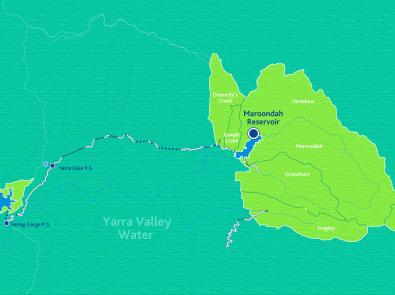Re-directing water around Melbourne ensures all our drinking water needs are met
133 years ago, Melbourne Water started transferring water across the city from what is now known as the Maroondah Dam, via a network of aqueducts, now that same structure has evolved into one of the city’s most impressive responsive water supply systems.
The Maroondah water supply system – originally called the Watts River Scheme - has come a long way since Victoria’s Public Works Department (now called Melbourne Water) celebrated its opening on the 18th of February, 1891.
Back then, water was transferred via a 66 kilometre grid of open concrete aqueducts from Maroondah all the way to the city, via Preston Reservoir.
As population and water demand continued to grow, by 1927 the early system was replaced with a new, larger dam; and the Maroondah Reservoir has been supplying water to Melburnians ever since.
Over the years, the system has been continually upgraded and expanded enabling Melbourne Water to easily and safely transfer water between our storage reservoirs via aqueducts and water mains to ensure reliable water supply across Melbourne.
“Aqueducts were an important aspect of Melbourne’s initial supply system, and while they are still used to transfer water to our treatment plants, today’s modern water mains deliver the best quality water to our customers.” David Norman; Melbourne Water Head of Water Supply said.
“Our protected catchments, secure reservoirs and water treatment plants ensure Melbourne Water provides a safe, affordable and reliable drinking water supply to Melburnians.”

The early water supply system was solely gravity based, but today we utilise both gravity and pumping stations to provide greater scope for the transfer of water across our communities. This means we have increased flexibility in how we operate the system.
“Water redirection helps us to maximise our service resilience by moving water between different reservoirs,” Mr Norman added.
“For instance, we can increase supply to parts of Melbourne where water demand is high, respond to water supply interruptions due to repairs or maintenance, or the impact from natural disasters and weather events.”
The Maroondah Reservoir system, located near Healesville, supplies Melbourne with approximately 200 million litres of water per day, flowing via an aqueduct and tunnel system to the Yering Gorge Pumping Station on the Yarra River, near Yarra Glen. From there it is pumped into Sugarloaf Reservoir where it is then treated and supplied through an intricate network to Melbourne’s northern, western and inner suburbs.
But the Maroondah system is not alone in supplying water across Melbourne, our other catchments also have these capabilities. In addition, the Victorian Desalination Plant contributes, ensuring we have the right water supply for everyone now and for generations to come.
The Maroondah Water Supply System was added to the Victorian Heritage Register in 2018, affirming its rightful place in Victoria’s history and Melbourne Water’s place in community.
For key facts visit our Maroondah Reservoir page, and for a historical timeline visit our Maroondah water supply system page.
Media Contact: